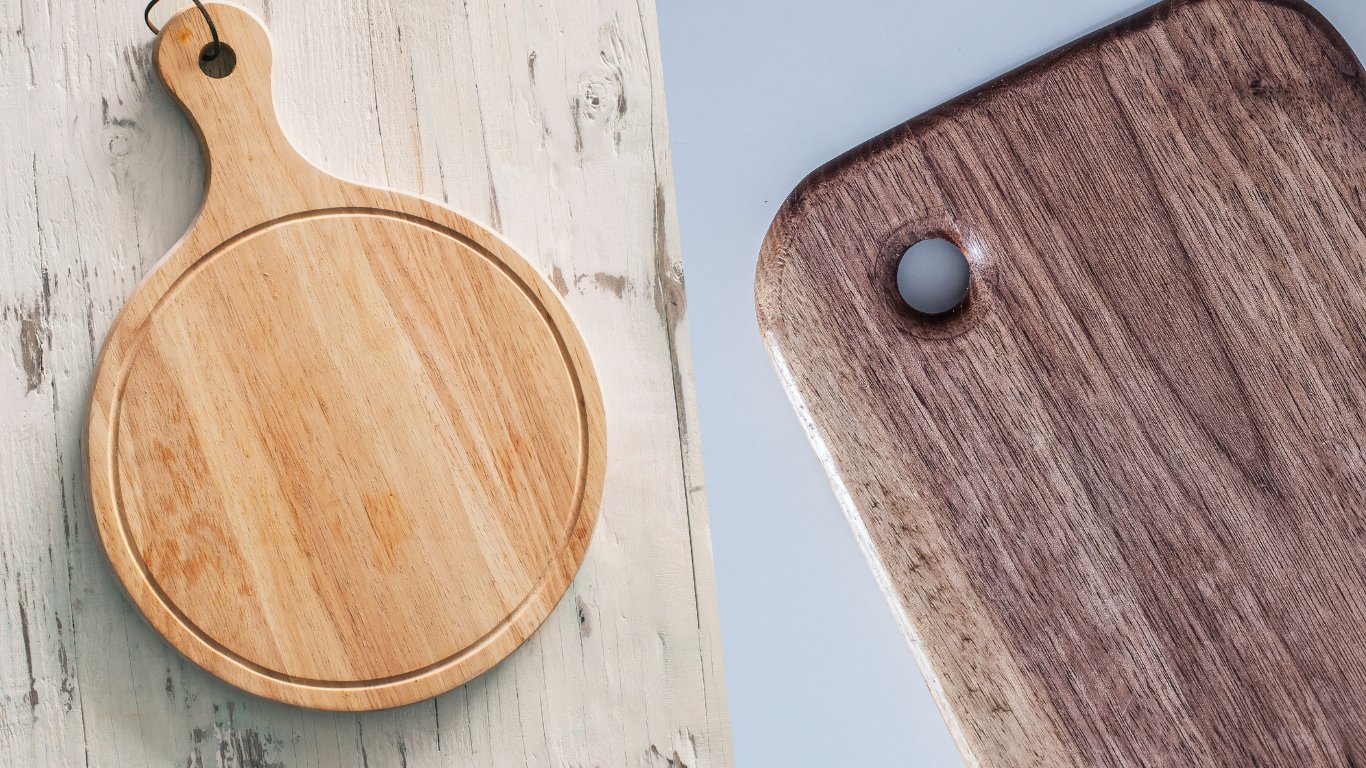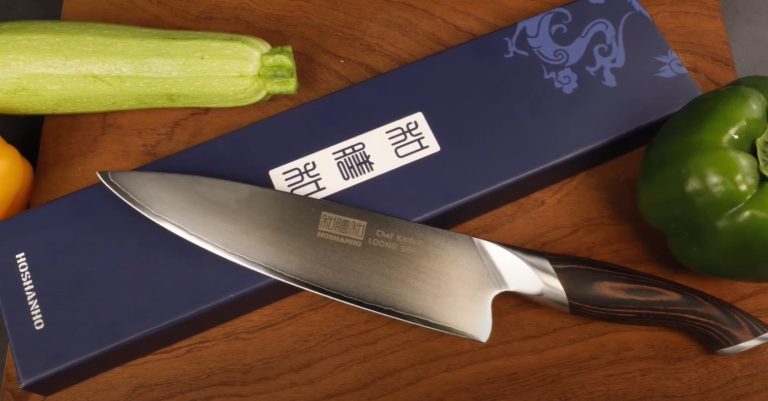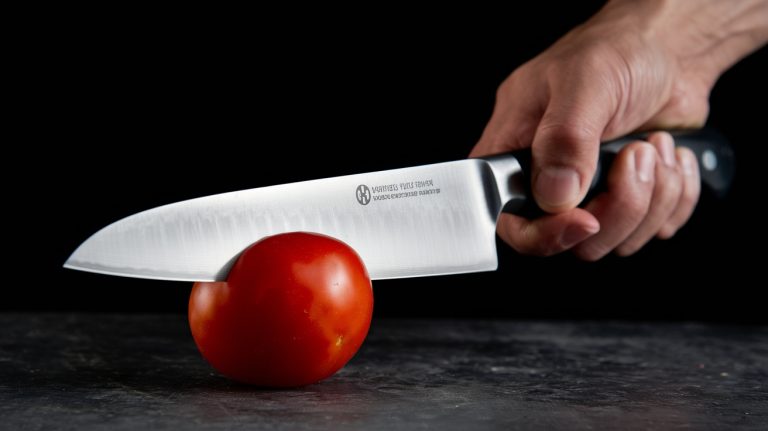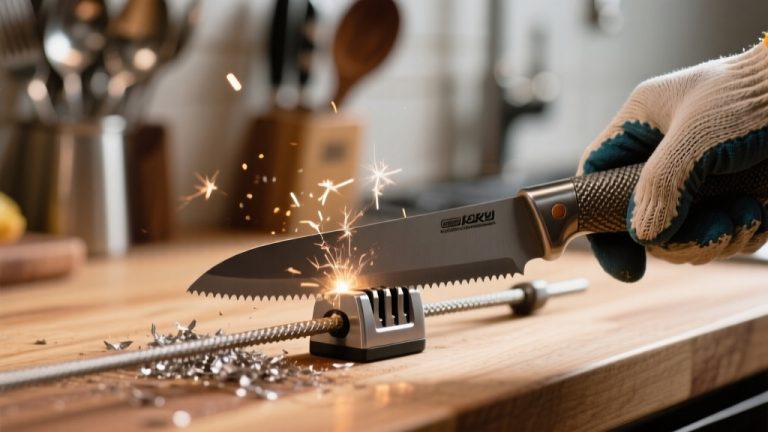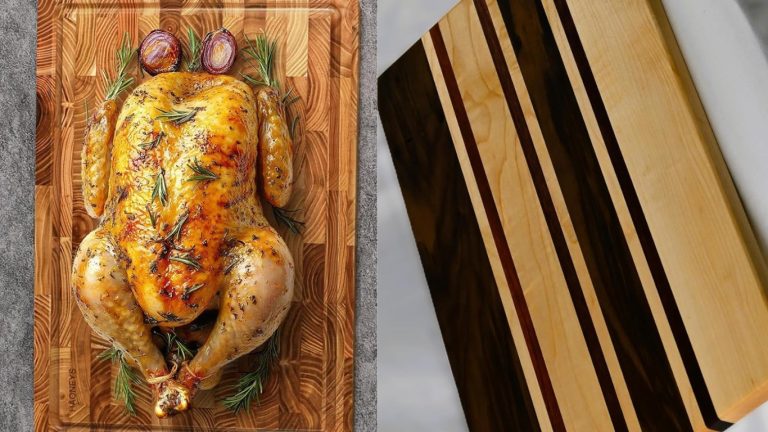Maple vs Walnut Cutting Board: Chop Smart
When choosing between a maple and walnut cutting board, you’ll notice maple’s Janka hardness of 1,450 pounds-force guarantees top-tier durability against wear and scratches, while walnut’s 1,010 rating offers a softer, knife-friendly surface.
Maple’s tight grain resists moisture and warping, whereas walnut needs frequent oiling to prevent drying.
Maple’s lighter weight aids handling, but walnut’s denser build prevents sliding. Stick around to uncover deeper insights into their unique benefits and care needs.
Key Takeaways
- Maple cutting boards are harder (Janka 1,450) than walnut (Janka 1,010), offering superior wear resistance.
- Walnut provides a softer surface, gentler on knives, especially Japanese blades, reducing edge wear.
- Maple has a light, uniform grain for a classic look; walnut offers rich, dramatic patterns.
- Maple is lighter and easier to clean, while walnut needs more frequent oiling for maintenance.
- Maple is more affordable ($29.95-$112.95) and sustainable; walnut is pricier due to scarcity.
Material Characteristics
Durability stands as a key factor when comparing maple and walnut cutting boards. You’ll notice maple boasts a Janka hardness rating of 1,450 pounds-force, making it highly resistant to wear and scratches.
It withstands frequent cutting in busy kitchens, showing fewer knife marks due to its tough surface. Maple’s dense grain structure also helps in resisting moisture and warping, contributing to its long-lasting performance.
Maple cutting boards shine with a Janka hardness of 1,450 pounds-force, resisting wear and scratches even in the busiest of kitchens.
Hard maple also excels in abrasion resistance, ensuring a smoother board over time. Additionally, maple’s dense grain structure dense wood grain provides an extra layer of durability for long-term use.
On the other hand, walnut, with a Janka rating of 1,010 pounds-force, offers durability but remains softer. While both hardwoods share dense structures contributing to longevity, maple’s straight grain adds to its robustness.
Visual Appeal
Aesthetics play an essential role in choosing between maple and walnut cutting boards, as their visual appeal can greatly impact your kitchen’s ambiance.
You’ll notice maple’s light, creamy tone and fine, uniform grain create a clean, neutral look, perfect for modern or minimalist designs. It reflects light, adding brightness and a classic touch.
Conversely, walnut’s deep, rich brown hue and striking dark streaks offer a luxurious, warm vibe, enhancing rustic or elegant settings. Its dramatic grain variations, especially in end-grain boards, showcase mesmerizing geometric patterns.
While maple ages with consistent uniformity, walnut develops unique character over time. Additionally, the finishes on these woods enhance their beauty, with maple often featuring a clear varnish and walnut typically treated with oil or wax for a lustrous shine.
Knife Compatibility
When considering knife compatibility, you’ll notice that maple’s higher Janka hardness rating of 1450 can accelerate knife edge wear compared to walnut’s softer 1010 rating, impacting edge preservation over time. This means maple boards may require more frequent sharpening when used regularly for cutting.
You’ll find walnut’s gentler surface reduces micro-chipping risks for delicate blades, while its end-grain construction offers cutting surface stability by distributing force evenly during heavy use.
Additionally, walnut is often recommended for Japanese knives due to its balanced hardness, making it a suitable choice for preserving the sharpness of thinner, high HRC blades balanced hardness.
If you’re using high-end knives, remember that walnut’s forgiving density paired with proper thickness—ideally 1.5 inches or more—enhances stability and protects your blade’s sharpness. Walnut’s rich, dark color also adds an elegant touch to your kitchen tools, blending both functionality and aesthetic appeal.
Knife Edge Preservation
As you evaluate cutting boards for knife edge preservation, you’ll find that both maple and walnut offer distinct advantages due to their inherent wood properties.
Maple, with a higher Janka hardness rating, provides a smooth, tight-grained surface that minimizes knife wear during precise cuts. Walnut, slightly softer, has a textured surface that grips food but introduces more friction, potentially affecting blade edges over time.
Both woods require proper maintenance, including regular oiling, to prevent drying and cracking and to maintain their durability and performance.
Opt for end-grain boards in either material, as they’re superior for knife sharpness retention by allowing easier blade penetration without edge damage. Remember that end-grain boards, while more expensive, are less prone to warping and provide long-term benefits for knife care end-grain superiority.
Maple withstands heavy use better, while walnut’s gentler density can be kinder to blades. Maintain both surfaces regularly to guarantee they remain knife-friendly, reducing dulling and the need for frequent sharpening.
Cutting Surface Stability
Explore the nuances of cutting surface stability, and you’ll notice distinct differences between maple and walnut boards that directly impact knife compatibility.
Maple’s smooth, uniform grain offers a consistent cutting plane, ensuring your knife glides effortlessly for precise cuts. Its harder density resists deep scoring, maintaining blade alignment. Additionally, maple’s Janka hardness of around 1450 lbf makes it significantly harder than walnut, providing superior resistance to wear.
Conversely, walnut’s denser, slightly textured surface grips food, preventing slippage during chopping, which enhances control.
Though softer than maple, walnut still supports knife stability with minimal wear, but its texture might slightly alter blade trajectory over time. Walnut’s moderate hardness of 1010 lbf and end-grain construction contribute to its knife-friendly properties.
Both woods resist moisture, reducing warping risks that could destabilize your cuts. Additionally, maple is often preferred in high-end boards for its durability and gentle knife interaction.
Usability Factors
As you evaluate usability factors for maple and walnut cutting boards, consider how ease of handling impacts your daily prep—maple’s lighter weight, due to lower density, makes it simpler to maneuver and store compared to the heavier walnut.
You’ll also notice cutting surface stability varies, with walnut’s denser build resisting countertop sliding better, while maple’s lighter frame might shift under heavy chopping unless secured. Additionally, both woods are hardwoods, ensuring they can withstand heavy-duty use.
Ease of Handling
When evaluating the ease of handling for maple and walnut cutting boards, you’ll notice distinct usability factors that impact your daily kitchen tasks.
Maple offers a smooth surface, giving you a comfortable cutting feel with minimal friction, ideal for precise slicing. Walnut, however, has a slight texture that enhances grip, helping secure food during preparation and reducing slippage risks.
Both boards strike a balance in weight—sturdy yet manageable, so you can move them effortlessly around your kitchen.
Their solid build guarantees portability without feeling cumbersome. Additionally, maple’s higher Janka rating of 1450 compared to walnut’s 1010 ensures greater scratch resistance over time, contributing to long-term usability.
Cutting Surface Stability
While evaluating cutting surface stability for maple and walnut cutting boards, you’ll notice key usability factors that directly affect performance during food prep.
Maple’s tight, uniform grain offers a smooth surface, ensuring precision with firm produce and resisting deep knife marks due to its higher Janka hardness (1,450 lbf). However, it can slide without non-slip pads due to lighter density.
In contrast, walnut’s varied grain provides natural texture, gripping wet or soft foods like tomatoes, though its softer density (1,010 lbf) shows more wear from cuts. Its heavier weight enhances countertop stability during aggressive chopping, reducing movement.
Both woods prevent rapid knife dulling, but maple’s structural rigidity and lower warp risk under moisture give it a slight edge for long-term consistency. Additionally, end grain construction in both woods enhances overall durability, making them suitable for heavy use over time.
Maintenance Effort Required
Beyond cutting surface stability, maintaining your maple or walnut cutting board demands specific attention to preserve its longevity and hygiene.
Wash it with warm, soapy water after use, drying thoroughly to prevent warping. Don’t soak it or use a dishwasher, as this risks structural damage.
Apply food-safe mineral oil monthly—walnut needs slightly more frequent oiling due to faster moisture loss. Use walnut oil for walnut boards to enhance color, avoiding vegetable oils to prevent rancidity.
Store upright in a ventilated area, away from heat sources. Rotate surfaces for even wear, sand minor scratches, and increase oiling in dry climates or winter. Our complete food-safe finish ensures superior water resistance, providing an added layer of protection for your board.
Care and Upkeep
As you maintain your maple or walnut cutting board, proper care and upkeep are essential to guarantee its longevity and performance.
Start by cleaning with mild dish soap only when needed, avoiding abrasive cleaners. Rinse with warm water, dry thoroughly with a towel, and stand it upright to air dry, preventing warping. Store it in a dry, ventilated area, away from extreme temperatures or heat sources like ovens.
For maintenance, apply food-safe mineral oil or beeswax monthly for heavy use, or every two to three months for lighter use. Use products like John Boos Mystery Oil, rubbing it in with a cloth along the grain.
Let it soak overnight, then wipe off excess. Test the board’s readiness for oiling by sprinkling water on the surface; if it absorbs rather than beads, it’s time to reapply oil for protection.
Health and Eco Aspects
Let’s shift focus from the care of your maple or walnut cutting board to the broader considerations of health and environmental impact. You’re choosing woods with natural antibacterial properties—maple inhibits bacterial growth, while walnut’s oils resist staining and microbes.
Both hardwoods boast closed-grain structures, minimizing cross-contamination risks. Environmentally, maple grows faster, using fewer resources, whereas walnut supports biodiversity through agroforestry.
Additionally, both woods are long-lasting when properly maintained, ensuring a sustainable kitchen investment.
Cost Analysis
Plunge into the cost dynamics of maple versus walnut cutting boards, and you’ll quickly notice a stark contrast driven by material availability and market positioning.
Maple boards, ranging from $29.95 to $112.95, benefit from abundant North American supply, keeping costs lower. Walnut, scarcer with higher raw material costs due to slower growth, often commands premium prices, amplified by its luxury image.
Production nuances, like walnut’s refined finishing and maple’s labor-intensive durability, further shape pricing. Brands like Boos Block vary widely, reflecting market strategies and regional sourcing challenges.
Additionally, walnut’s limited availability due to slower-growing trees slower-growing trees exacerbates the price disparity compared to the more readily available maple.
Feel the impact of these costs with:
- Affordability: Maple’s lower price eases your budget.
- Luxury: Walnut’s elegance tempts your style.
- Value: Maple’s durability secures long-term savings.
- Exclusivity: Walnut’s rarity elevates your kitchen prestige.
Frequently Asked Questions
Which Wood Matches Modern Kitchen Trends Better?
Hey, imagine crafting a kitchen that’s the envy of every trendsetter, a space where style meets savvy design.
You’re deciding on the perfect wood to sync with modern vibes. Opt for a timber that mirrors 2025’s airy palettes and minimalist flair, boasting tight grain for hygiene and low upkeep.
Its pale hue pairs with light schemes, while FSC certification guarantees eco-smart sourcing.
You’ll nail that cutting-edge aesthetic effortlessly!
Can These Boards Be Personalized Easily?
Hey, when you’re looking to personalize cutting boards, you’ll find it’s quite straightforward with many retailers.
Explore options at places like The Boardsmith or Hardenbrook Hardwoods, where you can engrave last names, dates, or “Est.” years without extra fees.
Expect standard engraving on one side, leaving the other for cutting. Rest assured, the process is precise, though it’s made-to-order, so plan for lead times of several weeks.
Are There Cultural Preferences for Either Wood?
Like a tapestry woven with history, cultural preferences for certain woods in kitchen tools often run deep.
You’ll notice that in some regions, you favor lighter hardwoods for their bright, traditional appeal in classic settings.
In others, you’re drawn to darker woods for their sophisticated, elegant vibe in modern designs.
These choices stem from local craftsmanship traditions and aesthetic values, reflecting precise regional tastes and historical material uses.
Which Wood Inspires More Creative Designs?
When considering which wood sparks more creative designs, you’ll find darker tones with bold grain patterns ignite your imagination.
You’re drawn to striking contrasts and intricate inlays, pushing boundaries with artistic edging and thematic versatility.
You’ll tackle woodworking challenges, leveraging textured surfaces for functional flair.
You can’t ignore how vivid natural patterns inspire unique, elegant aesthetics, driving you to craft visually stunning pieces with dramatic color variety and hybrid artistry.
Do Chefs Prefer One Over the Other?
Hey, you’re probably wondering if chefs have a clear preference when choosing between materials for their kitchen tools.
Immerse yourself in professional kitchens, and you’ll notice a trend: many favor maple for its uniform hardness and ease of sanitization, aligning with butcher block tradition.
Yet, walnut’s gaining ground with its aesthetic appeal and natural antibacterial properties.
You’ll see maple dominating commercial settings, while walnut often shines in upscale, presentation-focused environments.
The Verdict: Crafting Your Kitchen Legacy
So, you’ve weighed maple and walnut cutting boards, dissecting their grain and grit. Picture maple as a pale sunrise, soft yet unyielding under your blade, while walnut stands as a dark forest, rich and resilient.
Choose maple for budget-friendly durability, or walnut for deeper elegance. Whichever you pick, maintain it with precision oil it, clean it, and it’ll be your kitchen’s steadfast sentinel for years. Your culinary canvas awaits your decisive cut.

